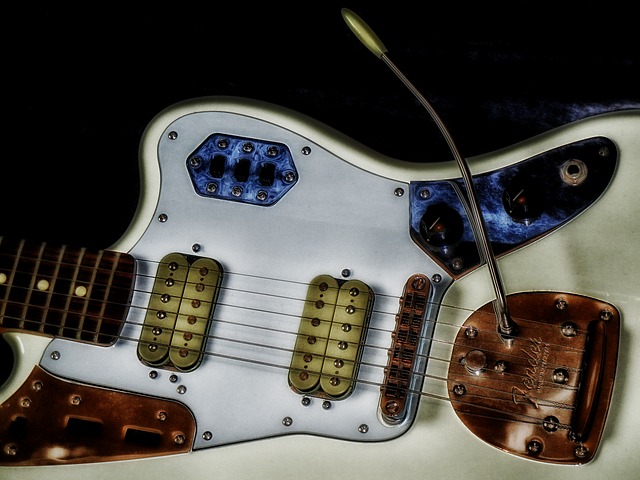Great Mixes Come from Great Arrangements: How to Craft a Mix-Friendly Song Arrangement
It an be argued that the making or breaking of a mix is really determined by the quality and strength of your song’s arrangement. Shortcomings in a song’s arrangement or production choices are a burden we all struggle with on a regular basis—whether knowingly or unknowingly.
Whether it’s frequencies from similarly-voiced instruments crashing into each other or rhythmic conflicts draining the song’s power and impact, these issues can make for a whole lot of havoc come mix day, often in the form of instruments “masking” one another, or generally cloudy-sounding tracks.
To head this kind of sonic trouble off at the pass, a little presence of mind, in terms of carving out or allocating distinct “space” via smart instrumentation and arrangement choices can go a long way toward achieving clearer, more focused final mixes.
For simplicity’s sake, we’ll start by breaking down our “Arranging Your Mix” game plan into two main categories: “Frequencies” and “Time.” Dig in, shall we?
Note: By getting into all this, the band might not be able to blow off that pre-production rehearsal for a night full of Jager shots. But, if they manage to stay sober and get down to the business of thoughtful arranging, their mix engineer, their music, their fans* and significant others (*if applicable) will most certainly be grateful.
Arranging for Frequency Balance
In order to unpack the idea of frequency or tonal allocation while arranging your mix, let’s sub-divide this concept into the traditional three, main sections of the frequency spectrum: Low-End, Mid-Range and Top-End.
Low-End
It’s no secret that getting the low-end right in any mix is always a bit of a slog. Hard-to-hear bass instruments conflicting and jockeying for the same sonic space inside a track is a recurring problem in many genres of music.
In addition to trying to remedy this dilemma through the use of mic placement, EQ, and so on, why not try and help solve the issue via arrangement and production options before you even get to the mix? Here are a few basic examples to get you into the right mindset:
Bass Guitar and Kick Drum:
 Ah, the age-old struggle for supremacy. Start off by asking yourself, “What kind of bass sound is this song looking for?” If, say, the answer comes back, “growling, throaty and percussive,” not only will you have you bass direction, but you will also now have, inadvertently, a direction for your kick drum.
Ah, the age-old struggle for supremacy. Start off by asking yourself, “What kind of bass sound is this song looking for?” If, say, the answer comes back, “growling, throaty and percussive,” not only will you have you bass direction, but you will also now have, inadvertently, a direction for your kick drum.
If the main personality of your bass guitar tone will be flirting with the low-mid area of the frequency spectrum, try playing, in a sense, a game of opposites, by crafting the sound of your kick drum to be lower, rounder, fat and beefy. By contrast, if the bass is meant to be deep and subby, then try to sculpt a kick drum tone that is leaner, tighter and punchier from the get-go.
This can be achieved through drum choice, head tuning, mic placement, etc. Simple actions like these can insure that your bass guitar and your kick will each have their own, more or less, distinct piece of sonic real estate.
The relative tone of each instrument, should also dictate the part each instrument plays, and vice versa. In general, the lower and deeper of the two instruments should be playing the less busy part, and the higher and leaner of these two low-end instruments should be playing the busier of the two parts. More on this general idea in the “Time” section below.
Sure, there will——and should—still be some frequency overlap to deal with come mix day, but by making this kind of pre-emptive strike through basic production choices, the battle for bottom-end supremacy should be less of a violent one.
Keyboards:
 Granted, keyboards are probably not the first instruments that come to mind when talking about the bottom-end of the frequency spectrum, but when you think of it, the lower octaves of even the most non-sub-woofer-threatening Spinet piano can still pack a decent punch.
Granted, keyboards are probably not the first instruments that come to mind when talking about the bottom-end of the frequency spectrum, but when you think of it, the lower octaves of even the most non-sub-woofer-threatening Spinet piano can still pack a decent punch.
In efforts to leave the majority of that low-end breathing room for your kick and bass, analyze your keyboard parts. In particular, look at what your left hand may be doing. (And get your mind out of the gutter, while you’re at it).
Many keyboard players, as a matter of course, will play a chord with their right hand and a root-note octave (thumb & pinky finger) with their left. This practice is great for solo piano playing or piano as sole vocal accompaniment, but, it can often serve to muddle up the low-end of a full-band mix. Substitute said piano with a fat, ‘80s-style synth and now you’ve got some real trouble brewing in the bottom (again, mind out of the gutter please).
Now, of course, this depends on the song, but if possible, see if your keyboard part—especially the lower octave portion—can be simplified. Perhaps the left hand part can even be eliminated entirely. Can that synth or B3 pad be played with only that right hand chord? And does it have to be a chord, or can one note do it? Can that vamping Wurlitzer part work with just the left hand playing one root note rather than an octave?
It might be a cliché, but less truly is more not only in terms of arrangement but also in regard to frequency spectrum. That hardly-heard, left hand octave played on that flabby synth patch may ultimately serve no real purpose other than to mask your bass guitar’s definition and clarity.
Sure, a high pass filter on the keys might help in the mix, but why not eliminate the issue from the get-go while making your arrangement lean and mean in the process?
This same kind of thinking can also be applied to guitars: Does every guitar part need the low 5th and 6th strings as part of every chord? As a general rule, the denser the mix, the wiser it is to leave more out of each instrument.
Mid-Range
The cold, hard reality of the audio world is that most sonic information for our tracks live within the mid-range frequencies. As such, when a track count multiplies so do the mid-frequency pile-ups.
Guitars, keyboards, vocals and more guitars, all adding to the mid-frequency free-for-all, are then usually left to a mix engineer to sort out in quiet desperation. How does one make all these disparate pieces with similar frequency DNA coexist and speak uniquely above the din?
One way, of course, is by using our standard mixing tools: EQ, compression, effects, etc. But another—dare I say better—way is to employ smart instrumentation and part choice. Here’s a quick example to get you thinking along these lines:
Guitars:
 Once again, playing a game of opposites in your quest for simplicity can carry you a long way. If, say, your tune has a bass part in place playing an 8th note pattern, it might be cool and classic to have an electric guitar chugging right along with it, right? Doubling the part, adding a little energy and texture?
Once again, playing a game of opposites in your quest for simplicity can carry you a long way. If, say, your tune has a bass part in place playing an 8th note pattern, it might be cool and classic to have an electric guitar chugging right along with it, right? Doubling the part, adding a little energy and texture?
If you do go this route, then it may be wise to resist the urge to do the same with your acoustic guitars. Sounds like ultra-simple advice, but the cardinal sin of over-doubling (“Dude, let’s pan them left and right!”) is super common in our unlimited track count, DAW world. (And is obviously not just limited to guitars).
Having your acoustics play the same, 8th note game along with your bass and your electrics will almost assure that they will never be heard in the context of the mix, all while the boxy, low-mid woofy-ness of the acoustics’ bottom strings only prove to muddy up the soundscape and mask other more important instruments.
It’s much better to think of another part for your acoustics to play: A counterpoint melody, an arpeggiated chord figure, or something else entirely. Who says they have to even be there at all?
By looking to simplify and diversify whenever possible, you will not only benefit the song by making sure that each part is essential enough to spark listener interest, but you will also help the clarity and impact of your mix while you’re at it.
Top-End
From cymbal crashes to vocal brilliance to just about everything else that lives in the world above 4 kHz, the top-end can help add shimmer, clarity and excitement to our songs. On the other hand, badly managed top-end can also offer washy phase issues, harshness and ear fatigue.
While careful recording and mixing techniques can help lessen these unpleasant occurrences, once again, some thoughtful arrangement practices can improve your high end,—and also help ward off the tinnitus. Here’s another example to head you down the right path:
Vocals:
As any experienced mix engineer will tell you, it can be a challenge to get vocals to sit properly in a mix while still retaining all the intelligibility and excitement a good vocal should have.
Among the many obstacles to getting vocals sounding great in a track is sibilance. Unfortunate byproducts of the mechanics of singing, plosive consonants and essy “S” sounds are a recurring nuisance to be dealt with. Recording and mix solutions such as mic choice and placement, pop screens and de-essers all help remedy the problem, but some good arranging technique can help as well.
Say you’re adding a direct harmony to run in tandem with your lead vocal track. Since you’ll be singing the same lyrics as the lead vocal, when recording the harmony above or underneath, try your best to sing the words without over-enunciating any of the consonants or sibilant “S” sounds found at the heads or tails of words. Some singers even become adept at leaving these sharp and slippery consonants out entirely on harmonies, doubles and background passages.
Sure, this technique will take a little practice getting used to. A lyric such as, “She loves you” might read more like, “she love_ you”. When listening to the track afterward in solo, things may sound a little unnatural, but by under-emphasizing the offending sounds in this harmony pass, you’ve helped limit some of the nasty sibilant build-up that occurs in the vocal overdub process.
Your lead vocal should already have all the consonant plosives and “S” sounds you could ever possibly need to make the vocal intelligible. So by limiting those sounds at the source in your vocal doubles and harmonies, you’re helping make your overall vocal presentation all the more cleaner and present in the mix. You can even add a whole lot more brightness and air to the vocal come mix time without running into half as many issues.
Arranging in Time
The second of our two major categories, Time, might not be as obvious of a concern, but it’s just as important a subject to consider.
Just like with frequency collisions within your track, timing issues— like phase on the technical end of things, and poor rhythmic choices on the instrumental side—can also create masking problems that detract from the clarity and focus of your mix.
Since technical issues of phase are topics more commonly addressed in these virtual pages and similar elsewhere, let’s focus on how smarter arrangement and production choices in the realm of time can help improve the intelligibility of our mix with a few more examples.
Percussion:
 Let’s give the drummer some – thing to think about. Here’s a classic example of how you can add a little separation and energy to your mix at the same time through intelligent instrument and part choice:
Let’s give the drummer some – thing to think about. Here’s a classic example of how you can add a little separation and energy to your mix at the same time through intelligent instrument and part choice:
Let’s say that on the chorus section of your song, your drummer is playing a quarter-note pattern on the ride cymbal. Since this is the chorus of your tune, you may want to add a percussion instrument to subtly ratchet up the excitement factor. As such, you might reach for a tambourine, but before you do, consider that a tambourine possesses similar frequency characteristics to that of the metallic ping and shimmer of your ride cymbal.
Once again, playing our old game of opposites, what else can we use instead of a tambourine to satisfy a similarly percussive role? How about a shaker egg? The shaker can easily perform the same function as the tambourine, but its “sandy” sonic qualities are quite different from those of the ride cymbal it will be playing up against. Using the shaker will allow both it and the ride to speak in the mix in a way that will not clash and will benefit each.
Now for those playing along at home, you might have noticed that this bit of sonic planning, thus far, could have easily been filed under the “Top-End” section of our “Frequencies” run-down above, but what makes it specific to “Time” is how the shaker will be played.
Since the ride is sounding a quarter-note pattern, try having the shaker play a 16th note pattern over top. Now, in addition to having a frequency-based separation between ride and shaker, your chorus will also benefit from a time-based differentiation, adding a higher level of clarity to the mix ,as well as more of that sense of variety and emotional energy-boost you originally desired.
This example may seem rudimentary to many studio veterans, but to a recording novice, and many an intermediate, the kind of thinking behind this illustration may prove to be a mini-revelation.
More Guitar:
 Perhaps you’re planning to have a vamping, choppy, electric guitar part skanking along in a quarter-note pattern throughout the intro of your song.
Perhaps you’re planning to have a vamping, choppy, electric guitar part skanking along in a quarter-note pattern throughout the intro of your song.
Rather than just playing the part in one pass on one guitar, try recording two guitars; each featuring a slightly different tone, with Guitar #1 sounding the one and three beat chords, while Guitar #2 plays on the twos and fours. Next, pan one guitar hard-left and the other hard-right in the stereo field (“Dude, let’s pan them left and right!”) and take a listen.
What you’ve created is, in a sense, an arrangement-powered ping-pong effect. It’s an effect that adds a bit of ear candy to your production, an effect far more unique and real sounding than any you could have created with a delay plug-in, and one which also creates some depth and space in you mix.
You don’t have to take this idea quite so literally. Simply by planning to have any two instruments that play rhythmic parts of similar tempo occupy different areas of the frequency (or left-right) spectrum will put you far ahead of many a lesser arranger
Summing it Up
Hopefully you’ve enjoyed this look at how some thoughtful arrangement and production decisions can promote clarity, help eliminate sonic conflict and put you ahead of the curve with your song projects come your mix day of reckoning.
Beyond absorbing the specific examples and tips laid out in the “Frequencies” and “Time” categories above, I hope these examples will serve as catalysts, pushing you toward a new way of thinking and a fresh mindset on production and arrangement.
Hopefully, in the weeks that come, you will find yourself increasingly embracing the “less is more” and “game of opposites” arrangement philosophies, ultimately leading you down the road to better songs and better mixes.
*Ok, now the band can go grab those Jager shots. I may have a few myself.
Mark Bacino is a singer-songwriter based in New York City.
When not crafting his own melodic brand of retro-pop, Mark can be found producing fellow artists or composing for television/advertising via his Queens English Recording Co.
Mark also is a Guitar World contributor and the founder/curator of intro.verse.chorus, a website dedicated to exploring the art of songwriting. Visit Mark on Facebook or follow him on Twitter.
Please note: When you buy products through links on this page, we may earn an affiliate commission.













Mike Levine
August 24, 2017 at 6:34 pm (8 years ago)Test